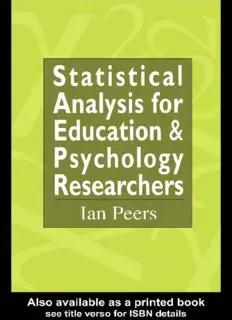
Statistical Analysis for Education and Psychology Researchers PDF
Preview Statistical Analysis for Education and Psychology Researchers
Statistical Analysis for Education and Psychology Researchers Statistical Analysis for Education and Psychology Researchers Ian S.Peers The Falmer Press (A member of the Taylor & Francis Group) London • Washington, D.C. To my wife Diane UK Falmer Press, 1 Gunpowder Square, London, EC4A 3DE USA Falmer Press, Taylor & Francis Inc., 1900 Frost Road, Suite 101, Bristol, PA 19007 © I.S.Peers, 1996 All rights reserved. No part of this publication may be reproduced, stored in a retrieval system, or transmitted in any form or by any means, electronic, mechanical, photocopying, recording or otherwise, without permission in writing from the Publisher. First published in 1996 This edition published in the Taylor & Francis e-Library, 2006. “To purchase your own copy of this or any of Taylor & Francis or Routledge’s collection of thousands of eBooks please go to www.eBookstore.tandf.co.uk.” The author has made every attempt to obtain all the necessary permissions, should any have been omitted we will do our best to correct this at reprint stage. A catalogue record for this book is available from the British Library Library of Congress Cataloging-in-Publication Data are available on request ISBN 0-203-98598-2 Master e-book ISBN ISBN - (Adobe eReader Format) ISBN 0 7507 0506 x paper Jacket design by Caroline Archer Contents List of Figures vi List of Tables xii Appendix—List of Figures and Tables xv List of Statistical Symbols xviii List of Formula xx Acknowledgments xxiii Preface xxiv 1 Statistics and Research Design 1 2 Measurement Issues 17 3 Initial Data Analysis 33 4 Probability and Inference 84 5 Choosing a Statistical Test 117 6 Inferences Involving Binomial and Nominal Count Data 159 7 Inferences Involving Rank Data 203 8 Inferences Involving Continuous Data 248 Appendix 344 References 405 Index 411 List of Figures 1.1 Effect of teacher confounded with treatment (group) 11 1.2 Effect of teacher controlled 12 1.3 Two-way (unrelated) completely crossed factorial design 13 (one-factor ‘sex’ with two levels and one-factor ‘method’ with three levels) 1.4 Statistical guidelines for planning a quantitative study 16 3.1 Coding sheet for children’s reasoning ability data set 36 3.2 Example of a data file, data set child1.dat 38 3.3 Example SAS programme using PROC COMPARE 40 3.4 41- Log file for the PROC COMPARE programme 43 3.5 Output for the PROC COMPARE programme 43 3.6 Example SAS programme to produce a data listing, for the 46 data child1 3.7 SAS output from PROC PRINT, for the data child1 46 3.8 Example SAS programme for a frequency count using 47 PROC SUMMARY 3.9 SAS output from PROC SUMMARY, data=child1 47 3.10 Vertical and horizontal frequency bar charts 53 3.11 Stem and leaf plot of the variable ASCORE1 (Total A-level 54- points score) 55 3.12 Split stem and leaf plot for the variable AGEY (age in years) 55 3.13 Box and whisker plot for the variable ASCORE1, total A- 57 level score (stem and leaf plot adjacent) 3.14 Stated limits and real limits for the two lowest score 60 intervals in Table 3.4 3.15 Histogram for the variable age in years 62 3.16 Theoretical normal distribution curve 66 3.17 Positively and negatively skewed distributions 67 3.18 SAS output from the program check.job. (Missing and out- 81- of-range values are printed) 82 4.1 Overview of the empirical research process 85 4.2 Pascal’s triangle of expected outcomes 95 4.3 Distribution of male pulse rates 105 4.4 Statistical power and Type I error 113 4.5 Type II error 113 4.6 A summary of the possible outcomes of the decision-making 114 process 5.1 127- Decision chart for choosing a statistical test 28 5.2 Output from SAS programme POWER1 135 5.3 Sample size estimates for two different proportions 136 5.4 How to determine estimates of pie1 and pie2 for a 2×2 cross- 137 over design 5.5 Output from SAS programme POWER2: Estimated power 138 for difference between means (independent groups) 5.6 Output from SAS programme POWER2: Estimated sample 139 size for power set to 80 per cent 5.7 SAS code for POWER3 programme to determine power and 141 sample size for the related groups design (example 5.5) 5.8 Estimated power for the difference between means (related 141 measures), output from SAS programmes POWER3 5.9 Percentage correct score of syntactic awareness (difficult 143- reading passage) with a positive skew 144 5.10 Percentage correct score of syntactic awareness (easy 145- reading passage) with a negative skew 146 5.11 147- Vocabulary (raw scores) approximate normal distribution 148 5.12 Histogram and normal probability plot for log transformed 151- variable ‘CORRD’—percentage correct difficult reading 53 passage 5.13 Histogram and normal probability plot for arcsine 155- transformed variable ‘CORRD’—percentage correct difficult 156 reading passage 5.14 Histogram and normal probability plot for arcsine 157 transformed variable ‘CORRE’—percentage correct easy reading passage 6.1 Number of former students reporting increased 166 understanding of educational issues as an effect of the MEd programme 6.2 Method of contacting parents by type of school child 167 attended 6.3 171- Output for Chi-square analysis 172 6.4 Ten subjects with upper limb injuries selected at random 181 6.5 183- Output for Fisher’s exact test 184 6.6 SAS output for r×k Chi-square analysis 195 6.7 Contingency table for vocabulary acquisition experiment 198 6.8 Data entry section of SAS programme for computing 199- Cochran’s Q 201 6.9 SAS output from Cochran’s Q analysis for vocabulary data 201 7.1 Interpreting scatterplots for two variables 206 7.2 Scatterplot of %FSME and %CAT scores for ten schools 210 7.3 Plot of upper- and lower-school teachers estimated 222 percentage of active learning maths lessons 7.4 Output for Wilcoxon M-W test using PROC NPAR1WAY 225 7.5 SAS code for computation of the Wilcoxon Signed Rank 230 statistic 7.6 Output from PROC univariate for paired difference best- 230 poor relationship 7.7 Output from PROC NPAR1WAY for reading correction 236 data 7.8 Post hoc pairwise multiple comparisons for reading 238 corrected data in Table 7.5
